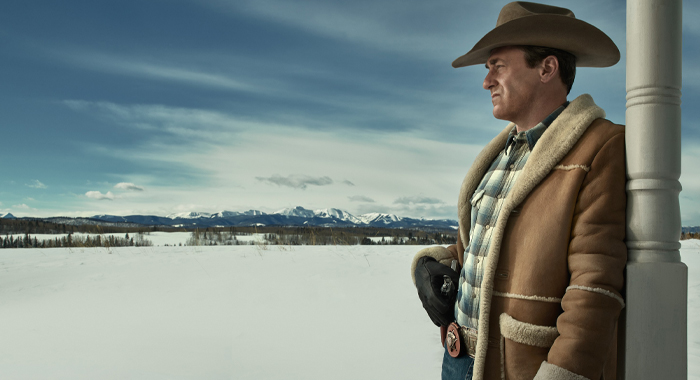This November, FX released the fifth and possibly final season of the popular anthology series Fargo. Based on the 1996 film by Joel and Ethan Coen, and set in that film’s extended universe (every property needs one these days), Fargo the series has been some ride thus far. Since its debut in 2014, the show has offered viewers red-blooded American gore blended with a unique flavor of small-town sweetness, and dared us to ask why the two pair so well.
Details about this fifth season didn’t betray much. A teaser dropped in which Jon Hamm, dressed for cattle rustling, swaggers into a diner, picks a strip of someone else’s bacon off their plate, and growls: “Who do I gotta kill to get a coffee?” This follows promotional images of Hamm, Juno Temple, Jennifer Jason Leigh, and Joe Keery in costume as late-teens North Dakotans, their expressions singing of closely guarded secrets. But perhaps most intriguing is the tagline that FX posed months ago to suggest the trajectory of this season: “When is a kidnapping, not a kidnapping, and what if your wife isn’t yours?” This would seem to suggest that Season 5 will play closer than any prior season to the premise of the original film, in which car salesman Jerry Lundegaard (William H. Macy) hires two thugs to kidnap his wife in a ransom scheme designed to exploit his rich father-in-law.
While details differ from one season to the next, certain types persist. In every season, a seemingly mild-mannered character somehow runs afoul of an underworld figure connected with a powerful crime syndicate. The conflict between these characters causes a buildup of bodies, attracting the attention of a capable law enforcement officer who must hastily piece together what’s happening and make the killing stop. Creator Noah Hawley’s challenge thus far has been to do the same thing four times without repeating himself. Or, put the opposite way, it has been to explore different thematic territory each time without altogether crossing the series’ city limits.
In this effort, Fargo has enjoyed mixed success. The first and second seasons superbly projected the film’s ambiance onto the wider canvas of a multiplot drama series, aided by strong turns from such veterans as Billy Bob Thornton and Kirsten Dunst, as well as breakout performances from Allison Tolman, Colin Hanks, and Bokeem Woodbine. The third, released just three months after Donald Trump took office, felt like Fargo for the age of ‘alternative facts,’ using its lexicon of character and motif to articulate our struggle to define what impact, if any, truth still has on the way we live our lives. Darker than what had come before, and ending in a state of suspension that mirrored our own uncertainties, Season 3 seemed to stretch the boundaries of what this show could accomplish without trading its identity for another.
Then came Season 4, a study in soaring ambition and distractingly weird names. Every strong point from this period has its asterisk. Chris Rock, as Loy Cannon, delivers an utterly committed, at times absorbing performance in the lead role, but one is often aware that he could be handling the drama slightly better, especially in the scenes he shares with the seasoned Glyn Turnan. Bank robbers played by Karen Aldridge (“Zelmaire Roulette”) and Kelsey Asbille (“Swanee Capps”) extend the Western genre’s palette and throat-punch its politics, but are often so cartoonish that you half-expect them to disappear through a painted-on tunnel in pursuit of the Roadrunner. And while it is admirable when every character in a series is allowed to speak for themselves, here that adds up to a quantity of talking that hasn’t felt intuitive since the days of the Victorian triple-decker novel. In its brief yet rather padded finale, Season 4 dropped from the ambit of disappointment to that of embarrassment, fumbling to tie up loose ends and repeating itself in all the wrong ways. (Using both the “Battle Hymn of the Republic” and “America, the Beautiful” in the same episode shows an unfortunate lack of confidence in the satiric thrust of either one.)
Re-watching the movie Fargo recently, I was struck by how eloquently it keeps quiet. Sure, the accents and catchphrases still grab you by the shoulders, but the film also has its gentle touch. Much of that comes from the hand of Frances McDormand’s character, local police chief Marge Gunderson, who is never more impressive than while driving a captured killer back to civilization in her squad car. In the end, by practicing scrupulous police work and learning to trust her own instincts, she has collared her man, all while heavily pregnant. But five people are still dead, and in catching the culprit she has witnessed the excesses of violence and cruelty that people unleash on each other “for a little bit of money.” Between glances at the monster slumped in her back seat, she wonders aloud, like some of Melville’s characters, how nature and human nature can clash so much: “And here ya are, and it’s a beautiful day…” Then, cutting the engine, she watches backup approach through a curtain of snow, and, before exiting the vehicle, delivers one of the more quietly heartbreaking lines in American cinema: “I just don’t understand it.” The Coens would achieve similar pathos the following decade using Tommy Lee Jones’ character in No Country for Old Men. But if Jones’ Sheriff Bell, chilled by the winter of life, speaks sorrowfully of a hypothetical “man” who would “have to put his soul at hazard” to be part of our violent world, Marge clearly fears for one participant in particular: her unborn child. The latter’s anxiety cuts us deeper by having so real an object.
For too many reasons, any well-wrought portrayal of ordinary people feeling hopelessly overmatched by life itself seems destined to find a receptive audience in our time. Hawley’s Fargo has always been alive to this aspect of the film, even reimagining the squad car scene multiple times over. If Season 4 was too densely populated with aggressively eccentric characters to give anyone their due, it might be hoped that Season 5 will narrow its gaze a little, renewing Fargo’s signature sensitivity toward characters who struggle—silently violently, or otherwise—with the brooding companionship of things they just don’t understand.

















